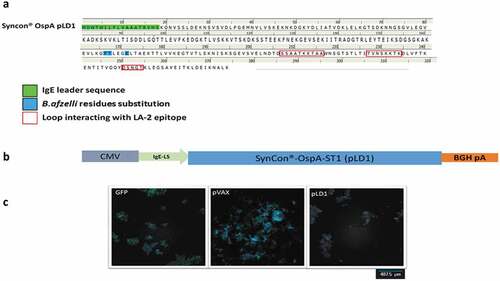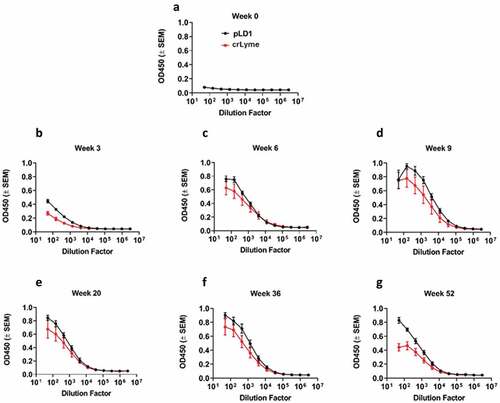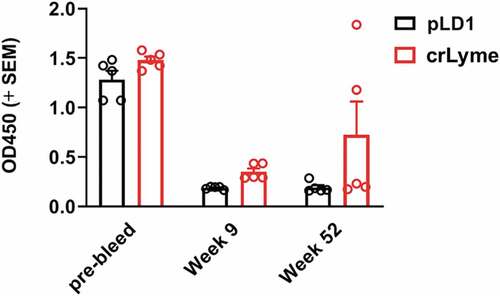Figures & data
Figure 1. Engineering of SynCon® sequence of OspA DNA vaccine pLD1. (a) Protein sequence of pLD1. (b) Schematic of pLD1 construct, OspA antigen is encoded in a pVAX plasmid under CMV promoter. The IgE leader sequences were inserted at the 5ʹend to enhance protein expression. (c) Immunofluorescent image of 293 T cells transfected with GFP, pVAX or pLD1, nucleus stained for DAPI (blue) and immune-stained for anti-OspA (red Alexa fluor® 555 stain).

Figure 2. Robust humoral and cellular immune responses are elicited by pLD1 in C3 H/HeN: C3 H/HeN mice received the number of doses of pLD1, crLyme and pVAX as indicated and described in materials and methods. (a) OspA antigen binding of IgG in serial serum dilutions from C3 H/HeN mice measured two weeks after the indicated dose. Data shown represent OD450 nm values (± SEM) for sera OspA antigen binding for each group. (b) OspA-specific IgG endpoint serum binding titer (EBT). The antibody EBT titer was defined as the highest dilution of serum with OspA binding OD values two times the background of pre-bleed serum. (n = 8 per group). (c) C3 H/HeN mice received three doses of pLD1, pVAX, or crLyme vaccine as described in the materials and methods. T cell response was evaluated two weeks after the third dose by measuring the number of IFN-γ producing spot-forming units (SFUs) generated per 106 splenocytes after stimulation with OspA peptide pools. Data show mean SFU±SEM (n = 5 per group).

Figure 3. Immunization with pLD1 confers protection against Borreliella burgdorferi bacterial challenge in C3 H/HeN mice: (a) Schematic of the experimental protocol pertaining to Borreliella burgdorferi bacterial challenge study. (b) Bacterial burden in joints, heart, bladder and ear was assessed by PCR in C3 H/HeN mice four weeks after the bacterial inoculation. Data show the mean ± SEM amount of Borreliella genome per 10,000 internal β-actin gene in indicated tissues. (c) Bacterial killing/growth inhibition assay was evaluated under dark-field microscope: 100,000 bacteria were incubated at 37°C in presence of serially diluted serum (see Material and methods) to assess the endpoint titer ± SEM at which bacterial growth is visible (n = 8 per group).

Figure 4. Robust and sustained humoral response after intradermal immunization with pLD1 in Hartley guinea pigs. Guinea pigs were immunized at three-week intervals with pLD1 or the crLYME vaccine as described in materials and methods. (a–g) OspA antigen binding of IgG in serial serum dilutions from guinea pigs. Data shown represent OD450 nm values (± SEM) for each group from week 0 to week 52 (n = 5 per group).

Figure 5. Immunization with pLD1 elicits humoral response against LA-2 epitope. A competitive inhibition ELISA was performed with serum from guinea pigs (dilution 1:50, n = 5 per group for Pre-bleed, week 9 & 52) and LA-2 binding mAb 319–44. O.D values for 319–44 mAb binding to OspA in presence of guinea pig sera from immunized animals.

